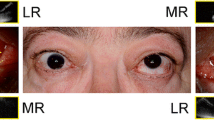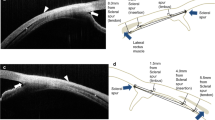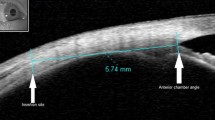Abstract
Purpose
To purpose if this study was to determine whether the horizontal rectus muscle tendons (HRMTs) can be observed using anterior segment optical coherence tomography (AS-OCT) and to determine the repeatability of its measurements. Also, this study aimed to observe and measure the different external ocular structures at the level of the horizontal rectus muscle (HRM) insertion.
Methods
This was a retrospective, observational, descriptive and comparative study. Images were obtained utilizing the RTVue 100 CAM system. Eyes were analyzed at the three and nine o’clock position. Scans were performed for three different locations: the limbus, the ciliary body and the equator. All scans were analyzed by two graders, separately and blinded. Measurements were performed for: HRMT length; HRM thickness; conjunctival epithelium thickness; conjunctiva and Tenon’s capsule thickness; scleral thickness; and external ocular thickness.
Results
Results were obtained from twenty eyes of ten volunteers. The conjunctival epithelium thickness was 52.33 μm, the total conjunctiva/Tenon’s capsule thickness was 313.54 μm, the medial rectus (MR) thickness was 136.63 μm and the lateral rectus (LR) thickness was 181.65 μm. The MR tendon length was 1,426.88 μm, the LR tendon length was 1,433.65 μm, the scleral thickness was 489.91 μm and the total external ocular structure thickness was 785.17 μm. Intra-observer reproducibility (intraclass correlation coefficient [ICC]) for tendon length was 0.993 for grader #1, 0.989 for grader #2; the muscle thickness ICC was 0.990 for grader #1 and 0.981 for grader #2. The inter-observer reproducibility ICC for tendon length was 0.557; the ICC for muscle thickness was 0.834.
Conclusions
It is possible to visualize and measure HRMTs using AS-OCT. Measurements of the HRM, as well as the surrounding external ocular tissues, can be achieved.




Similar content being viewed by others
References
Huang D, Swanson EA, Lin CP et al (1991) Optical coherence tomography. Science 254:1178–1181
Sull AC, Vuong LN, Price LL et al (2010) Comparison of spectral/fourier domain optical coherence tomography instruments for assessment of normal macular thickness. Retina 30:235–245
Leitgeb R, Hitzenberg C, Fercher A (2003) Performance of fourier domain vs. time domain optical coherence tomography. Opt Express 11:889–894
de Boer JF, Cense B, Park BH et al (2003) Improved signal-to-noise ratio in spectral-domain compared with time-domain optical coherence tomography. Opt Lett 28:2067–2069
Spaide RF, Koizumi H, Pozzoni MC (2008) Enhanced depth imaging spectral domain optical coherence tomography. Am J Ophthalmol 146:496–500
Branchini L, Regatieri CV, Flores-Moreno I et al (2012) Reproducibility of choroidal thickness measurements across three spectral domain OCT systems. Ophthalmology 119:119–123
Radhakrishnan S, Rollins AM, Roth JE et al (2001) Real-time optical coherence tomography of the anterior segment at 1310 nm. Arch Ophthalmol 119:1179–1185
Huang D, Li Y, Radhakrishnan S (2004) Optical coherence tomography of the anterior segment of the eye. Ophthalmol Clin North Am 17:1–6
Hoerauf H, Wirbelauer C, Scholz C et al (2000) Slit-lamp-adapted optical coherence tomography of the anterior segment. Graefes Arch Clin Exp Ophthalmol 238:8–18
Wirbelauer C, Karandish A, Haberle H, Pham DT (2005) Noncontact goniometry with optical coherence tomography. Arch Ophthalmol 123:179–185
Radhakrishnan S, Huang D, Smith SD (2005) Optical coherence tomography imaging of the anterior chamber angle. Ophthalmol Clin North Am 18:375–381
Ramos JLB, Li Y, Huang D (2009) Clinical and research applications of anterior segment optical coherence tomography - a review. Clin Exp Ophthalmol 37:81–89
Hoerauf H, Gordes RS, Scholz C et al (2000) First experimental and clinical results with trans-scleral optical coherence tomography. Ophthalmic Surg Lasers 31:218–222
Liu X, Wang F, Xiao Y, Ye X, Hou L (2011) Measurement of the limbus-insertion distance in adult strabismus patients with anterior segment optical coherence tomography. Invest Ophthalmol Vis Sci 52:8370–8373
Park KA, Lee JY, Oh SY (2014) Reproducibility of horizontal extraocular muscle insertion distance in anterior segment optical coherence tomography and the effect of head position. J AAPOS 18:15–20
McGraw KO, Wong SP (1996) Forming inferences about some intraclass correlations coefficients. Psychol Methods 1:30–46, Correction;1(4): 390
Apt L (1980) An anatomical reevaluation of rectus muscle insertions. Trans Am Ophthalmol Soc 78:365–375
Sevel D (1986) The origins and insertions of extraocular muscles: development, histologic features, and clinical significance. Trans Am Ophthalmol Soc 84:488–526
Demer JL, Clark RA, Kono R et al (2002) A 12-year, prospective study of extraocular muscle imaging in complex strabismus. J AAPOS 6:337–347
Tamburrelli C, Salgarello T, Vaiano AS et al (2003) Ultrasound of the horizontal rectus muscle insertion sites: implications in preoperative assessment of strabismus. Invest Ophthalmol Vis Sci 44:618–622
Solarte CE, Smith DR, Buncic R, Tehrani NN, Kraft SP (2008) Evaluation of vertical rectus muscles using ultrasound biomicrospcopy. J AAPOS 12:128–131
Porter JD, Barker RS, Ragusa RJ, Brueckner JK (1995) Extraocular muscles: basic and clinical aspects of structure and function. Surv Ophthalmol 39:451–484
Oh SY, Poukens V, Demer JL (2001) Quantitative analysis of rectus extraocular muscle layers in monkey and humans. Invest Ophthalmol Vis Sci 42:10–16
Kono R, Poukens V, Demer SJ (2005) Superior oblique muscle layers in monkey and humans. Invest Ophthalmol Vis Sci 46:2790–2799
Demer JL, Oh SY, Poukens V (2000) Evidence for active control of rectus extraocular muscle pulleys. Invest Ophthalmol Vis Sci 41:1280–1290
Ruskell GL, Kjellevold Haugen IB, Bruenech JR, van del Werf F (2005) Double insertions of extraocular muscles in human and the pulley theory. J Anat 206:295–306
Demer JL, Miller JM, Poukens V et al (1995) Evidence for fibrovascular pulleys of the recti extraocular muscles. Invest Ophthalmol Vis Sci 36:1125–1136
Feng Y, Simpson TL (2008) Corneal, limbal, and conjunctival epithelial thickness from optical coherence tomography. Optom Vis Sci 85:E880–E883
Zhang X, Li Q, Liu B et al (2011) In vivo cross-sectional observation and thickness measurement of bulbar conjunctiva using optical coherence tomography. Invest Ophthalmol Vis Sci 52:7787–7791
Feng Y, Simpson TL (2005) Comparison of human central cornea and limbus in vivo using optical coherence tomography. Optom Vis Sci 82:416–419
Conflict of interest
All authors certify that they have no affiliation with or involvement in any organization or entity with any financial interest (such as honoraria, educational grants, participation in speakers’ bureaus, membership, employment, consultancies, stock ownership or other equity of interest and expert testimony or patent-licensing arrangements) or non-financial interest (such as personal or professional relationships, affiliations, knowledge or beliefs) in the subject matter or materials discussed in this manuscript.
Author information
Authors and Affiliations
Corresponding author
Rights and permissions
About this article
Cite this article
Salcedo-Villanueva, G., Paciuc-Beja, M., Harasawa, M. et al. Identification and biometry of horizontal extraocular muscle tendons using optical coherence tomography. Graefes Arch Clin Exp Ophthalmol 253, 477–485 (2015). https://doi.org/10.1007/s00417-014-2862-5
Received:
Revised:
Accepted:
Published:
Issue Date:
DOI: https://doi.org/10.1007/s00417-014-2862-5




